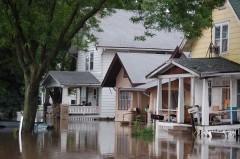
Why does climate change lead to more floods and droughts?
During 24 Hours of Reality, you heard 24 presenters say we expect more floods and droughts around the world as the planet warms. Some places, like Brazil and the southern U.S., may see more of both.
But don't just take our word for it.
Here at Climate Reality, we pride ourselves on bringing you the latest evidence from credible, peer-reviewed sources. So let's do a quick tour of what scientists are saying. (The links to these scientific documents are in PDF format.)
One point to remember is the water vapor that feeds rain and snowstorms comes from two sources. About 60% of the rain and snow over land comes straight from the oceans, and the other 40% is "recycled" over the continents. China, for example, gets most of its rain and snow from evaporation over Eurasia.
The rate of evaporation from the ocean seems to be increasing as the world warms. Think about heating a large pot of water on your stove -- the higher you turn the dial, the faster the water evaporates. Globally, this higher rate of evaporation is contributing to an increase in the average annual amount of rain and snow.
At the same time, the atmosphere is getting warmer, meaning it can hold more moisture. The intensity of downpours (and therefore the risk of floods) depends in part on how much water the air can hold at a given time.
So far, it sounds like the world is getting wetter, right? Well hang on -- we're not done yet.
Contrary to what you might expect, more intense rain doesn't necessarily mean wetter soils. Rain that falls as a violent downpour doesn't do much to help crops or other plants. Instead of gently soaking into the soil, heavy rain can cause flooding, but then quickly run off into rivers to be carried back to the sea. Furthermore, even though evaporation is increasing, it's not increasing as quickly as the water holding capacity of the atmosphere. This means it takes longer for water to recharge in the air after a downpour, and there is little to no rain between downpours. Finally, the rate of evaporation over land is limited by the amount of moisture in the soil. Early evidence suggests that globally, the rate of water loss from soil and plants (called "evapotranspiration") has declined, a finding reinforced by a global slowdown in plant growth.
Of course, the occurrence or severity of a particular drought or flood in a particular location depends on a lot of things, including natural climate patterns like El Nino. We've always had extreme weather, and we always will. The takeaway is that pumping carbon pollution into the air is like trying to beat someone playing with crooked dice. We may get lucky for a spell, but we can't beat the odds forever.
Thanks to the Paris Agreement, world leaders are honoring their commitments to climate action and working together to solve the climate crisis. Take the pledge and show them your support!
Image source: U.S. Geological Survey


